Home » Posts tagged 'debt' (Page 17)
Tag Archives: debt
Don’t Wait For the Storm to Pass–Learn to Dance in the Rain!
DON’T WAIT FOR THE STORM TO PASS – LEARN TO DANCE IN THE RAIN!
Whoever doesn’t learn to dance in the rain will struggle to survive the virtually non-stop storms that the world will experience in the next few years. The abrupt downturn in the global economy, triggered but not caused by coronavirus, came as a lightning bolt out of the blue. Thus, most people are paralysed and will fall helplessly as the world unwinds 100 years of mismanagement and excesses, caused primarily by bankers, both central and commercial.
2006-9 WAS JUST A REHEARSAL
I have for years warned about the enormous risks in the financial system that inevitably would lead to a collapse. As the bubble continued to grow for over ten years since the 2006-9 crisis, very few understood that the last crisis was just a rehearsal with none of the underlying problems resolved. By printing and lending $140 trillion since 2006, the problem and risks weren’t just kicked down the road but made exponentially greater.
So here we are in the spring of 2020 with debts, unfunded liabilities and derivatives of around $2.5 quadrillion. This is a sum that is impossible to fathom but if we say that it is almost 30x global GDP, it gives us an idea what the world and central banks will have to grapple with in the next few years.
THERE WILL BE NO V OR U RECOVERY
No one should believe for one moment that once CV is gone we will experience a V shaped recovery. There will be no V, there will be no U and nor will we see a hockey stick recovery. What few people understand, including the so called experts, is that there will be no recovery at all. An extremely rapid decline of the world economy has just started and will be devastating in the next 6-12 months, whether CV ends soon or not.
…click on the above link to read the rest of the article…
Who’s Next to Fail in the Post-COVID World?

As much as I hate to invoke The Ayn Rand lest I give off the impression I’m some kind of Objectivist, which I am most certainly not, the engine of the world is coming to a halt.
Money velocity has been falling for years. It is now cratering as we hide in our homes from a bug that eventually we will all have to reconcile with. Credit is the engine of the world of today.
It is the gas which fuels the engine of the world.
COVID-19 has cratered the global economy exposing the internal rot within our hyper-financialized global economy as nothing more than a pyramid of Ponzi schemes…
… piling credit on top of credit until there are no more greater fools to sell the new debt to.
That’s the system we have. And it is collapsing precisely because the world is situated at the point where there is little more productive capacity to monetize and pull that capital from the future to fund the new debt.
It won’t matter if we replace this system with pure helicopter money without debt as the Modern Monetary Theory proponents argue. We’re already doing a version of this by having the central banks buy debt they never intend to sell on the open market. So, the debt itself is without value. The money printed from those bonds is as much scrip as if the bond had never been issued.
But the time lost by people in pursuit of uneconomic ends by mispricing risk and servicing debt they are legally obligated to service is real.
The engine is sputtering as trillions are printed to kick it back over one more time. But the gas has too much ethanol in it. There’s not enough air.
…click on the above link to read the rest of the article…
Atlas Is Shrugging
Atlas Is Shrugging
“Government help to business is just as disastrous as government persecution… The only way a government can be of service to national prosperity is by keeping its hands off.”
– Ayn Rand
Congress has just approved an economically bloated $2.2 trillion spending relief bill, an amount more substantial than the GDP of all but a handful of countries. It is only the third massive relief bill, and we’ve been told several trillion dollars more would have to get spent. Then there are the trillions of dollars more of Federal Reserve Board liquidity injections.
We are starting to talk about real money here.
The politicians believe that sending $1,200 checks to people will “stimulate” the economy.
Among the many mistaken provisions of this new law is a welfare benefit to workers that pays them more money if they quit and become unemployed than if they stay on the job.

Here we go again.
A decade ago, during the height of the folly of the bank bailouts and trillions of dollars of spending for “shovel-ready projects” (that didn’t create jobs but plunged our nation into greater indebtedness), I noted in a Wall Street Journal article that with each successive bailout and multibillion-dollar economic stimulus scheme from Washington, the politicians were reenacting the very acts of economic stupidity that Ayn Rand parodied in her 1,000-page-plus 1957 novel “Atlas Shrugged.” In many surveys, “Atlas” rates as the second most influential book of all time behind the Bible.
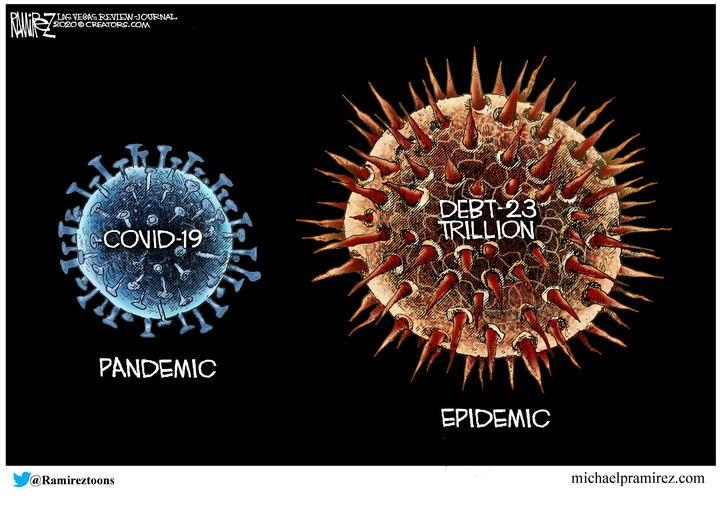
For those of you who have not read it (first, shame on you!), the moral of the story is that politicians invariably respond to crises—that, in most cases, they created—by spewing out new, mindless government programs, laws and regulations.
These, in turn, generate more havoc and poverty, which inspires the politicians to spawn even more programs. At which point, the downward spiral repeats itself until there is a thorough societal collapse.
Isn’t this precisely what is happening now?
West Faces “Social Bomb” As Pandemic Sparks Unrest Among Poorest
West Faces “Social Bomb” As Pandemic Sparks Unrest Among Poorest
The next phase of the COVID-19 pandemic could be a flare-up of social unrest across major Western cities as millions have lost their jobs, economies have crashed into depressions, and the military is being called up to maintain order.
The Federation of Red Cross and Red Crescent Societies (IFRC) warned that riots could be imminent in low-income neighborhoods as extreme wealth inequality has left households unprepared and without a cash buffer to weather the economic downturn.
As we’ve noted before, many Western households were already stretched thin before the shutdowns began, with little savings, insurmountable debts, and the lack of access to proper healthcare. Now, these folks, which many have been laid off from gig-economy and service sector jobs, have zero income and could be emotionally motivated to hit the streets and protest.
IFRC president Francesco Rocca warned on Friday during a press conference that social unrest could be imminent in Italy, reported Reuters.
“We have a lot of people who are living very marginalized, in the so-called black hole of society… In the most difficult neighborhoods of the biggest cities, I am afraid that in a few weeks, we will have social problems,” Rocca said.
“This is a social bomb that can explode at any moment, because they don’t have any way to have an income,” he said, whose agency deploys volunteers across Europe, including in Italy, Spain, and France.
He warned that the largest Western cities have only a ‘few weeks’ before social unrest is seen.
As for the US, President Trump has been deploying National Guard units across the country to fight the virus, or a perfect cover to prepare for Martial law-style shutdowns across some areas where the virus is hard-hitting.
…click on the above link to read the rest of the article…
Greatest Depression Already Started – Gerald Celente
Greatest Depression Already Started – Gerald Celente
Gerald Celente, a top trends researcher and Publisher of The Trends Journal, says the world is already in an economic depression. Celente explains, “Never in the history of the world has the whole world, or most of the world, been shut down by politicians destroying people’s lives and their businesses. People are going to go bankrupt. You are going to see suicide rates increase. You are going to see crime escalate and people OD’ing on drugs because of depression. . . . Our leaders are totally closing down the economy. Again, this has never been done before. It’s not only Wall Street going down, Main Street went down simultaneously. That is unprecedented. Usually, the markets go down and then the ripple effects start hitting Main Street. This time–boom, they are both down. . . . It’s going to be worse than the Great Depression. It’s going to be the Greatest Depression.”
What’s the biggest problem the economy faces? Celente says, “The debt levels are phenomenal. We have more than $250 trillion of global debt and all the personal debt. How are you going to pay the credit card debt? How about paying the student debt, car loans and the mortgages? What about the electric bill, phone bill and people are out of work because my governor said I should stay home?”
The next play by global governments is to get rid of cash because it carries germs like the coronavirus. Celente says, “We are going to go from ‘Dirty Cash to Digital Trash,’ which is also the title of the current Trends Journal. They’ve got people freaked out. They are going to give us digital trash. That’s what they are doing. They are going to get rid of the currencies that you have.”
…click on the above link to read the rest of the article…
Italian Debt Crashes Prompting ECB Intervention
Italian Debt Crashes Prompting ECB Intervention
Welcome to the brave new world of a helicopter money, aka the Magic Money Tree (MMT), where everything is crashing and nowhere more so than in Europe, which having made a dramatic U-turn on its historic fiscal stinginess, and where a flood of debt is now expected, bond yields across the continent are soaring even as European stocks crater, and nowhere more so than in Italy where the 10Y bond yield, which was trading below 1% as recently as one month ago, exploded as high as 2.99% this morning, before easing some of the rout following media reports that the ECB is intervening via the Bank of Italy.
Earlier in the session, Italy’s 10-year yield climbed as much as 64bps to 2.99%, pushing the BTP-bund spread up to 44bps wider to 323bps, the most since 2018 after a La Stampa report that Rome may extend the nationwide lockdown to beyond April 3.
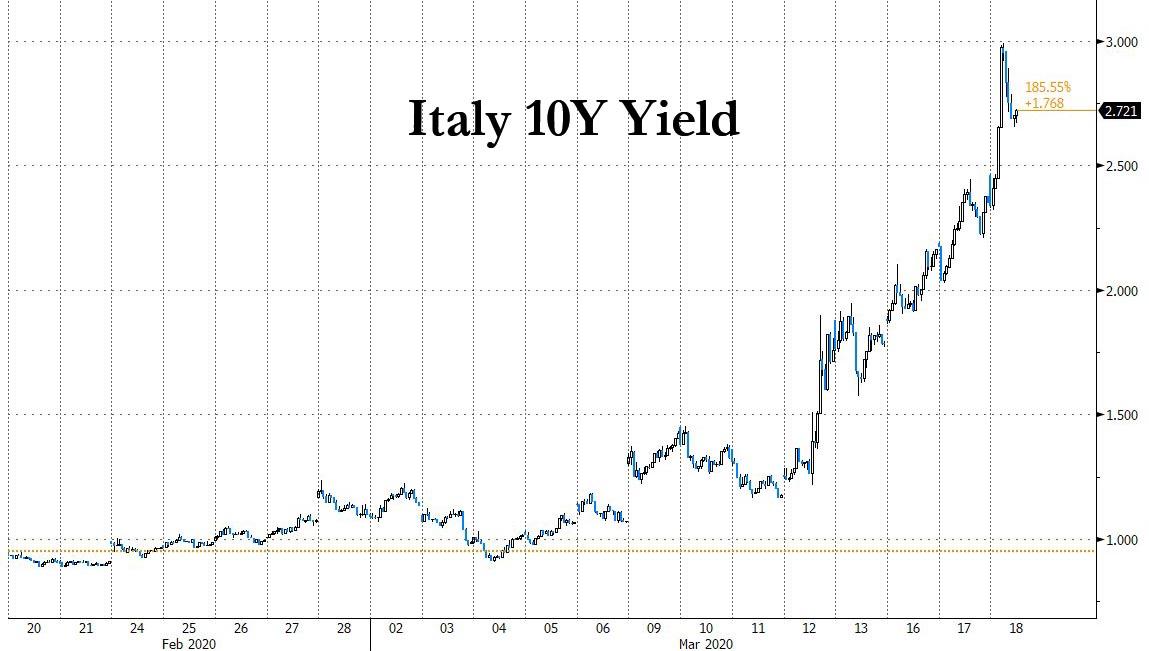
Then shortly after 6am ET, Italian bonds trimmed declines after Radiocor reported the ECB was invervening in the domestic market through the Bank of Italy. “Moves are flexible in terms of timing and of markets targeted, and can continue as long as needed”, Radiocor news agency reported, citing central banking sources.
Even that, however, barely made a dent, with Italy’s 10-year yield still almost 40bps higher at 2.72% after earlier climbing to 2.99%.
There was no ECB intervention in other European bonds, although they certainly also need it, with Bunds suffering sharp losses as the 10Y Bund yield surged as high as -0.20%…
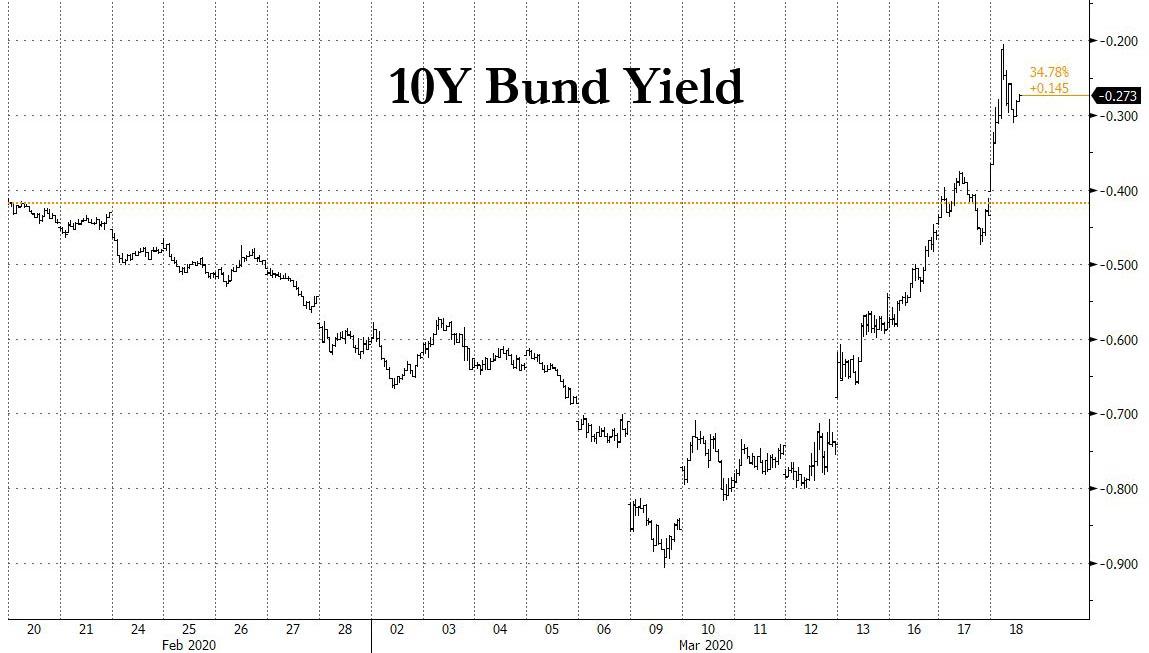
… although paring some losses following reports Germany was softening opposition to Italy’s proposal for joint EU bond issuance: German’s 30-year swap spread narrows 11bps to 0bps, the tightest since 2014, amid concerns that any fiscal loosening will lead to more bond issuance.
…click on the above link to read the rest of the article…
Toxic Loans Around the World Weigh on Global Growth
Toxic Loans Around the World Weigh on Global Growth
Preface. Obviously endless growth on a finite planet is impossible. Clearly the main “benefit” of debt is being able to rape and pillage the planet immediately. The accumulating debt can never be paid off, because energy is required to grow GDP (they’re locked in a death embrace) and death begins when oil declines, so will GDP, and most debts won’t be repayable. All of this debt allows us to extract resources NOW at the expense of future generations.
Here’s a recent article about debt, though not as good as it could be, since as usual, it’s energy and resource blind, but it’s probably clear to most people who read it that this can’t end well: December 2019 The Way Out for a World Economy Hooked On Debt? Yet More Debt (Bloomberg).
February 5, 2016 The Chart of Doom: When Private Credit Stops Expanding…
***
Eavis, P. February 3, 2016. Toxic Loans Around the World Weigh on Global Growth. New York Times.
Beneath the surface of the global financial system lurks a multi-trillion-dollar problem that could sap the strength of large economies for years to come.
The problem is the giant, stagnant pool of loans that companies and people around the world are struggling to pay back. Bad debts have been a drag on economic activity ever since the financial crisis of 2008, but in recent months, the threat posed by an overhang of bad loans appears to be rising.
China is the biggest source of worry. Some analysts estimate that China’s troubled credit could exceed $5 trillion, a staggering number that is equivalent to half the size of the country’s annual economic output.
…click on the above link to read the rest of the article…
Lebanon Announces Default On $1.2BN Debt Payment In Historical First
Lebanon Announces Default On $1.2BN Debt Payment In Historical First
Lebanon announced Saturday it will default on its Eurobond debt for the first time in its history. The protest-racked country has seen a recent change in government, banks opened for merely about half of the past few months, strict controls on hard currency withdrawals and transfers abroad amid a liquidity crisis, a plummeting Lebanese Lira since October, a run on dollars, and crushing public debt which has lately blown up to nearly 170% of its gross domestic product (now about $89.5 billion).
Prime Minister Hassan Diab confirmed in public statements the bond payment of $1.2 billion due on Monday will not be paid: “The debt has become bigger than Lebanon can bear, and bigger than the ability of the Lebanese to meet interest payments,” he said in a televised address. “We are paying the price for the mistakes of the past years. Must we bequeath them to our children?”

The broader crisis is being widely described as the worst and most potentially destabilizing disaster since the 1975-90 civil war. It also means that the country’s bond which mature on Monday and which last traded at a price of 57 cents on the dollar (or roughly 8000% YTM) won’t be repaid.
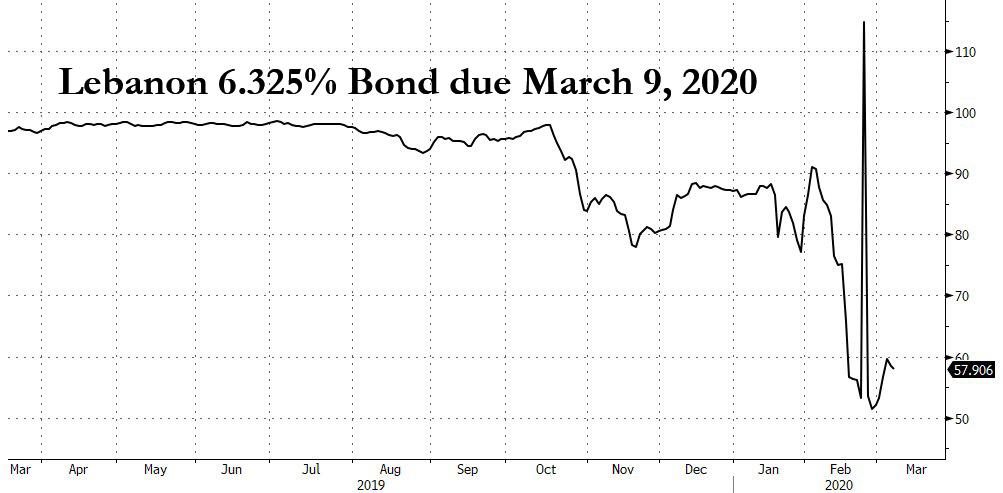
Local banks, which own some of the Eurobonds set to mature on March 9, have long argued against a default. But clients also fear the continued rapid depletion of their savings. Diab, appearing to respond not only to the people in the streets but to criticisms from the West centered on the Mediterranean nation’s decades of state corruption, pledged to continue negotiations to restructure the country’s debt “with all creditors… in a manner consistent with the national interest.”
…click on the above link to read the rest of the article…
Next Economic Downturn May Last Forever And A Day
Next Economic Downturn May Last Forever And A Day
Market Manipulation Has Created Big Problems
Based on how Japan has fared over the last several decades it is difficult to see the green shoots of a global economic spring forth as a result of lower interest rates. In fact, the next economic downturn will likely envelope the planet and may last forever and a day. This is because central bank intervention and manipulation often carries with it negative unintended consequences. People often forget how lucky Japan has been during its trying times to be located next to China. Because of China’s years of booming growth, Japan has been able to mitigate much of the pain that occurred when its economic bubble burst in 1992.
In the decades since, Japan’s stock market has never again come near the lofty peak it hit back then. During the years after Japan’s fall from grace, it was able to soften the impact of its economic problems by strengthening ties with rapidly growing China which needed help in developing its export-driven economy. Today many people feel the global economy is in a bubble eerily similar to the one experienced by Japan before its implosion. The question is not whether the market and economy are about to undergo a massive reset but when. Concern is also growing as to how deep, painful, and long the next downturn will last.
A huge factor in the world trudging forward following 2008 is the massive growth in the money supply and debt over the last several decades. This growth in debt and credit has exploded making the financial sector a far bigger part of our economy than it should be. The economy has become more about asset values than solid growth in production, this has added to inequality and this does not create a healthy environment for investors.
…click on the above link to read the rest of the article…
No, The Fed Will Not “Save the Market”–Here’s Why
No, The Fed Will Not “Save the Market”–Here’s Why
The greater the excesses, speculative euphoria and moral hazard, the greater the reversal.
A very convenient conviction is rising in the panicked financial netherworld that the Federal Reserve and its fellow dark lords will “save the market” from COVID-19 collapse. They won’t.
I already explained why in The Fed Has Created a Monster Bubble It Can No Longer Control (February 16, 2020) but it bears repeating.
Contrary to naive expectations, the Fed’s primary job isn’t inflating stock market and housing bubbles, though punters are forgiven for assuming that, given the Fed has inflated three gargantuan bubbles in a row, each of which burst (1999-2000, 2007-08 and now 2019-2020).
The Fed’s real job is protecting the banking/financial sector from a richly deserved and long overdue implosion. Blowing speculative asset bubbles is a two-fer, enabling rapacious, parasitic financiers and banks to profit from debt-serfs borrowing and gambling in rigged casinos (take your pick: student loan casino, housing casino, stock market casino, commodities casino, currency casino, etc.).
Blowing guaranteed-to-burst bubbles also generates a bogus PR cover, the Fed’s beloved “wealth effect,” an idiots’ delight belief that the greater the speculative bubble, the more tax donkeys and debt serfs will spend, spend, spend on defective junk and low-value services they don’t need–in essence, speeding up the global supply chain from China et al. to the local landfill, all in service of Corporate America profits.
The Fed’s secondary interest is maintaining some measure of control over the financial sector and the real-world economy it ruthlessly exploits. Just as the Fed gets panicky if interest rates start getting away from its control, the Fed also gets nervous when its speculative bubbles get away from it via infinite moral hazard:
…click on the above link to read the rest of the article…
Covid-19: Global Retrenchment Will Obliterate Sales, Profits and Yes, Big Tech
Covid-19: Global Retrenchment Will Obliterate Sales, Profits and Yes, Big Tech
If you think global demand will rebound as global debt and confidence implode, you better not be making consequential decisions based on Euphorestra-addled magical thinking.
Even before the Covid-19 pandemic, the global economy was slowing for two reasons: 1) everybody who can afford it already has it and 2) overcapacity. One word captures the end-of-the-cycle stagnation: saturation.
Everyone who can afford a smartphone (or can borrow to buy one) already has one. Everyone who can afford an auto loan already has a car. Everyone who could afford an overpriced house already bought one. Everyone who can afford a tablet or laptop already has one. And so on.
This saturation isn’t just in the consumer market–the corporate market is equally saturated. Corporations leased too much space, bought more cloud services than needed, increased headcount willy-nilly, and increased capacity just as the market for their goods and services stagnated from global saturation of markets and debt.
Paint-daubed members of the Keynesian Cargo Cult (paging Chief Humba-Humba Paul Krugman) love to claim that “debt doesn’t matter” but in their frenzied dance around the campfire they ignore one little feature of debt: interest. In a world in which money is borrowed into existence, all new money issuance and all new debt (the same thing) accrues interest.And as Japan has proven, even if the interest rate is near-zero, if you borrow relentlessly enough, the interest due even on near-zero interest rates soon dominates your entire income.
The Keynesian Cargo Cult, busy with their rock radios (the dials are painted on), ignore the sad reality that marginal borrowers default because they can’t afford to make the principal payments, never mind the interest, and the inevitable result is cascading defaults throughout the financial system.
It’s not just marginal borrowers who blow up; marginal lenders also blow up as all the loans they issued to marginal borrowers blow up.
Then there’s overcapacity. Yes there are shortages such as pork in China due to the spread of Swine Fever, but in one manufactured commodity after another, there is more capacity than customer demand.
…click on the above link to read the rest of the article…
China Injects A Record 5 Trillion Yuan In New Debt To Arrest Economic Crash
China Injects A Record 5 Trillion Yuan In New Debt To Arrest Economic Crash
There was a palpable sense of disappointment last night when instead of cutting its benchmark overnight interest rates, Loan Prime Rate, as some – notably Goldman Sachs – had speculated might happen, the PBOC announced that it would only lower its benchmark 1- and 5-year lending rates by 10bps to 4.05% and 5bps to 4.75% respectively, a move that was widely anticipated.
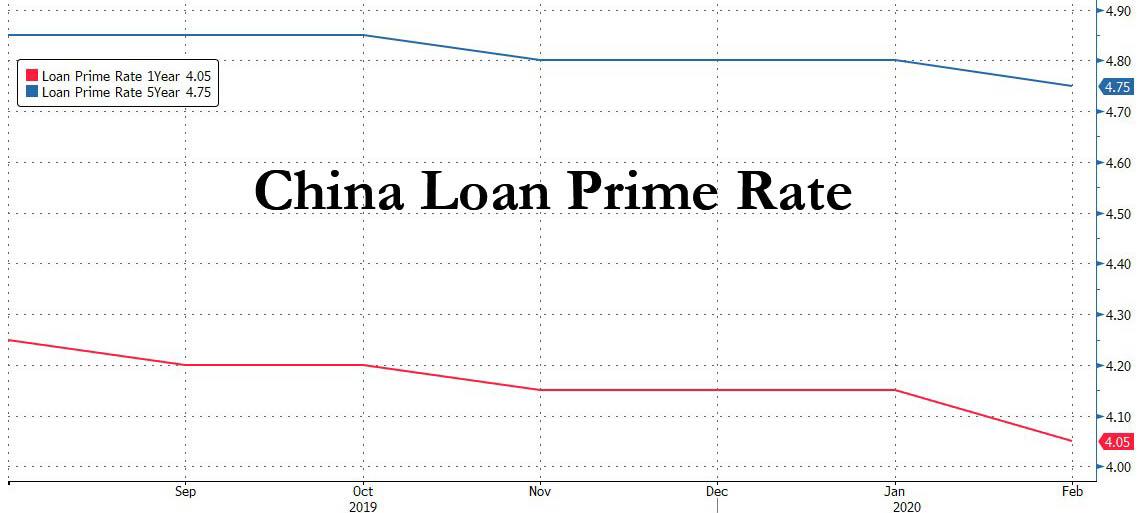
The underwhelming rate cuts left analysts asking for more as consensus emerged that piecemeal lending rate cuts can only help the Chinese economy so much, especially if China is indeed set to unleash fiscal austerity as local Chinese media reported over the weekend: “The ten basis point reduction will help companies weather the damage from the coronavirus at the margins,” Julian Evans-Pritchard, senior China economist at consultancy Capital Economics, wrote in a note after PBOC published its latest loan prime rates. “But even if the … cut is passed on to all borrowers, that would only decrease average one-year bank lending rates from 5.44% to 5.34%. The ability of firms to postpone loan repayments and access loans on preferential terms will matter more in the near-term.”
However the market’s bitter taste from the underwhelming rate cut was quickly reversed after the PBOC reported its latest monthly credit data, which was a whopper, blowing out market expectations: total social financing, the broadest credit aggregate, soared by over 5 trillion yuan, the biggest one month injection on record, surprising the market to the upside mainly on higher government bond issuance. According to Goldman, “this mainly reflected the economic conditions and policy stance as the economic impacts from the virus were still rising.”
Here is the summary from the January credit stats:
…click on the above link to read the rest of the article…
No One Gets Out Of Here Alive
NO ONE GETS OUT OF HERE ALIVE

“The seasons of time offer no guarantees. For modern societies, no less than for all forms of life, transformative change is discontinuous. For what seems an eternity, history goes nowhere – and then it suddenly flings us forward across some vast chaos that defies any mortal effort to plan our way there. The Fourth Turning will try our souls – and the saecular rhythm tells us that much will depend on how we face up to that trial. The saeculum does not reveal whether the story will have a happy ending, but it does tell us how and when our choices will make a difference.” – Strauss & Howe – The Fourth Turning
As we wander through the fog of history in the making, unsure who is lying and who is telling the truth, seemingly blind to what comes next, I look to previous Fourth Turnings for a map of what might materialize during the 2nd half of this current Fourth Turning. After a tumultuous, harrowing inception to this Crisis in 2008/2009, we have been told all is well and are in the midst of an eleven-year economic expansion, with the stock market hitting all-time highs.
History seemed to stop and we’ve been treading water for over a decade. Outwardly, the establishment has convinced the masses, through propaganda and money printing, the world has returned to normal and the future is bright. I haven’t bought into this provable falsehood. Looking back to the Great Depression, we can get some perspective on our current position historically.
The Dow is up 450% since its 2009 low, which is the metric used by the establishment to prove their money printing solutions have succeeded in lifting the country from the depths of despair and depression.
…click on the above link to read the rest of the article…
The Coming Exponential Silver Price Movement
The Coming Exponential Silver Price Movement
As the global highly-leveraged debt-based financial system comes under serious stress, investors are going to finally realize that the silver market is very tiny and extremely undervalued. This is when we will likely see the exponential silver price movement. And, it’s not a matter of “IF,” but rather a case of “WHEN.”
While most precious metals analysts focus on the systemic risks in the financial system to own Silver, I believe the real problem has to do with the HUGE ISSUES we are now facing with ENERGY. In my newest video, The Coming Exponential Silver Price Movement, I discuss the two reasons why I believe we are going to BIG MOVE in the silver price.
In the video, I show why the huge U.S. Total Debt to GDP of 346% is unsustainable due to the coming collapse of the U.S. Shale Oil Industry. Without oil production growth, there is no GDP growth. And, when there is no GDP growth, then the entire highly-leveraged debt-based financial system starts to disintegrate.

When Americans are faced with the task of “Protecting Wealth,” they will find out that “PAPER” or “DIGITS” will not make the CUT. Why? Paper money and Digits are based on future energy production. Thus, they are ENERGY IOU’s. However, Silver is money or wealth because it is a store of Energy Equivalent Value.
Also, in the video, I discuss some updated charts on U.S. Physical Silver Investment from 2010-2018 (Source: Metals Focus Silver Investment Report for the Silver Institute– OCT 2019):

…click on the above link to read the rest of the article…




